Key takeaways:
- Anti-war activism emphasizes dialogue, compassion, and community engagement to address the consequences of violence and war.
- Community mobilization strengthens the anti-war movement by uniting diverse perspectives and fostering shared values among individuals.
- Identifying local issues through personal conversations helps shape effective advocacy and connect community concerns to the broader movement for peace.
- Organizing events and sustaining engagement through ongoing initiatives, like book clubs and online platforms, promote lasting connections and collective action.
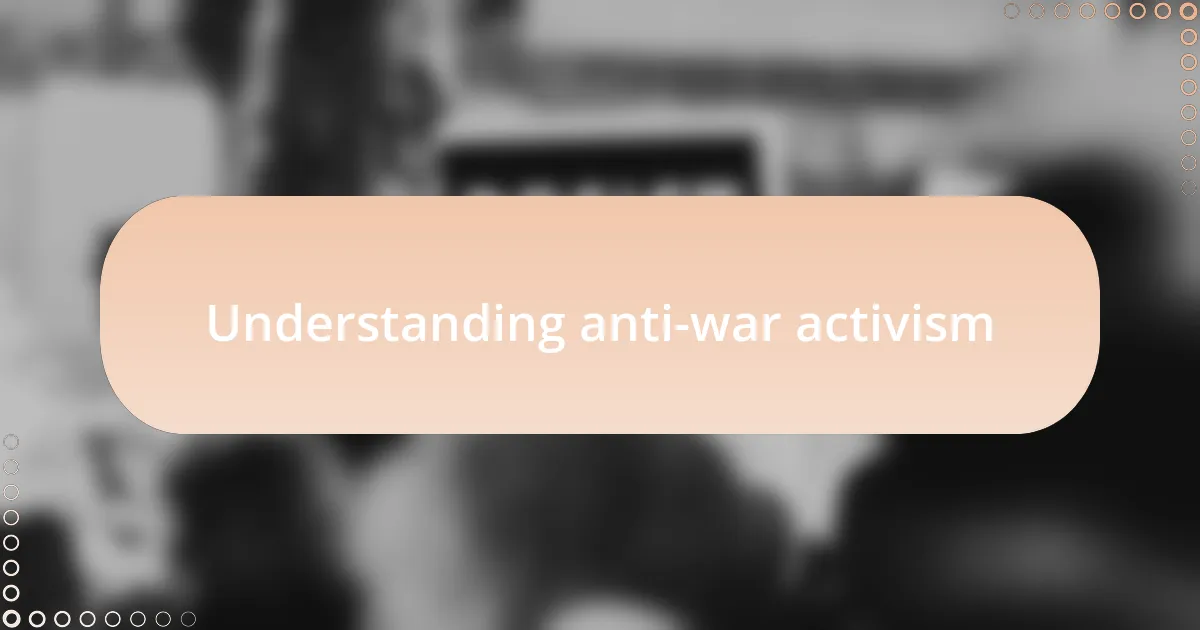
Understanding anti-war activism
Anti-war activism is rooted in the belief that conflict can and should be resolved through dialogue, compassion, and diplomacy rather than violence. I remember the first time I attended a peace rally; the energy was palpable, and I felt connected to a community that shared my desire for a world without war. But I often wonder, how do we move from individual convictions to collective action that truly impacts policy?
The emotional weight of anti-war activism often springs from personal experiences with the consequences of war. For instance, I recall meeting a veteran who spoke about the toll his service took on his mental health and his family. His story was a poignant reminder that behind every statistic lies a human being, and it challenges us to confront uncomfortable truths about the realities of conflict.
Understanding anti-war activism is not just about opposing war; it’s about recognizing the broader implications of our actions. I’ve discovered that fostering conversations in my neighborhood about the costs of militarization can be transformative. Is it enough to simply disagree with war? Or should we strive for a deeper understanding of how our communities can advocate for peace and healing instead? These questions drive my involvement and encourage me to engage with others to find meaningful answers together.

Importance of community mobilization
Community mobilization plays a pivotal role in shaping the anti-war movement. When people unite over a shared concern, a powerful energy emerges, amplifying individual voices to create a collective message. I vividly remember organizing a neighborhood meeting where we shared our stories and concerns; it was eye-opening to see how our individual experiences intertwined and strengthened our resolve to advocate for peace together.
Moreover, mobilization fosters a sense of belonging and support, essential elements in any activist effort. I’ve seen how a simple door-to-door outreach can spark genuine conversations about war’s impact, leading to unexpected connections and alliances. Could it be that the very act of reaching out—of making ourselves vulnerable—might be the catalyst for lasting change in our communities?
Lastly, community mobilization invites diverse perspectives that enrich our understanding of war’s impact. Engaging with people from various backgrounds has deepened my appreciation for the complexities surrounding conflict. It prompts me to ask: How do our collective narratives shape our vision for peace? These insights remind me that our efforts are not just about protesting war but fostering an environment where dialogue and empathy can flourish.
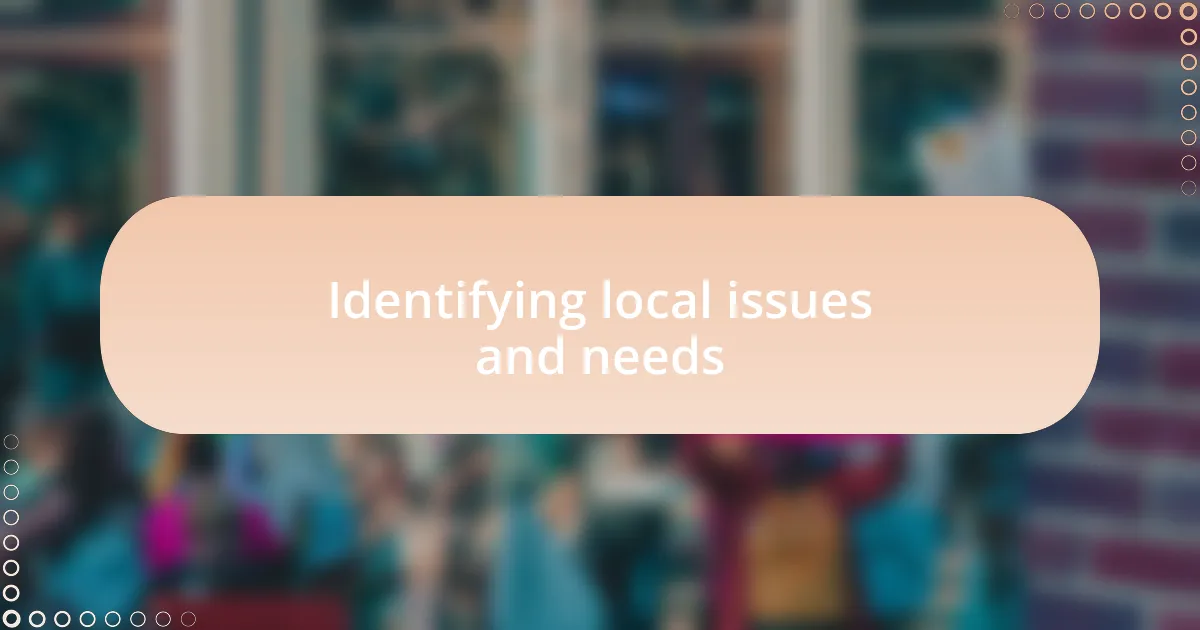
Identifying local issues and needs
Identifying local issues and needs often begins with simply listening. I recall one evening when a neighbor invited me for tea. As we chatted, she shared her worry about local veterans struggling to find mental health support. That conversation opened my eyes to an issue I hadn’t considered, making me realize that I needed to dig deeper into the needs of our community.
In my experience, community gatherings serve as the perfect platform for unearthing these local concerns. During one of our outdoor meetings, a young mother voiced her fears about her kids being groomed for militarization through video games and media. It struck me how intertwined our daily lives are with the broader implications of war. Isn’t it fascinating how one personal story can highlight a collective issue that demands attention?
Once we identify these pressing needs, we can frame our activism more effectively. I remember drafting a list of local resources and needs based on what community members discussed, which led to a focused campaign on providing support for families impacted by war. How impactful it is when we connect individual concerns to a larger movement! This approach makes our advocacy not just about lofty ideals but tangible solutions that resonate with our neighbors.
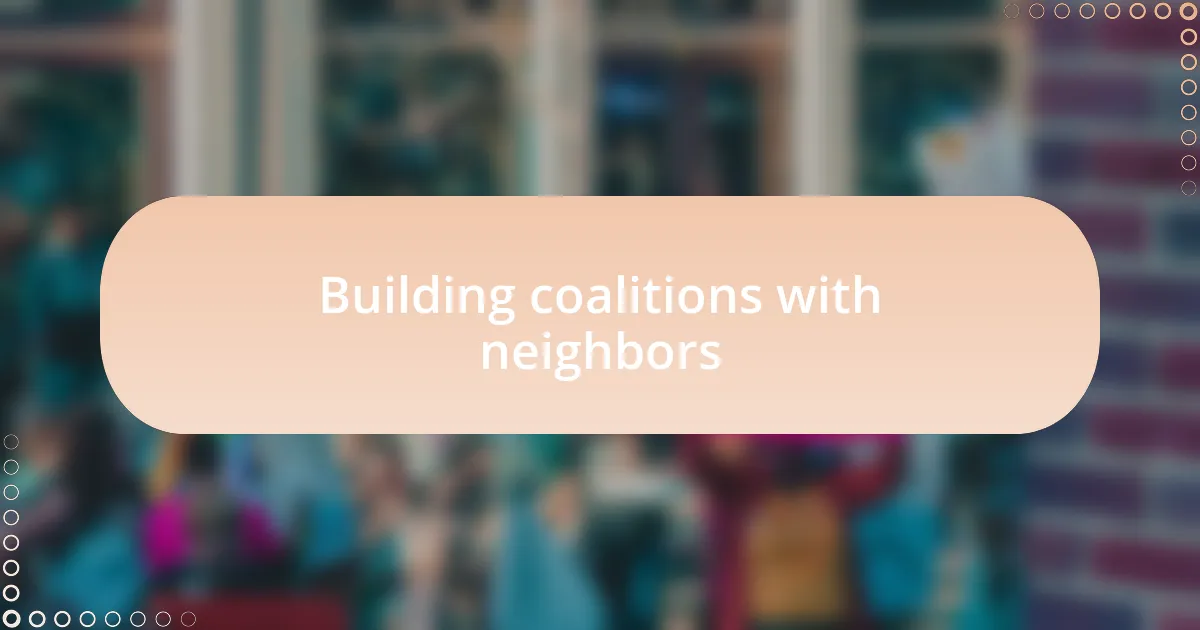
Building coalitions with neighbors
When I started to consider building coalitions with my neighbors, I realized the importance of common ground. One evening, I hosted a small potluck where everyone brought a dish to share. As we enjoyed the meal, I noticed how discussing our diverse backgrounds helped us identify shared values, like peace and security. Isn’t it heartwarming how food can bring people together to talk about pressing issues in our community?
I remember a conversation with a retired teacher who shared her passion for education and its role in fostering compassion. This discussion prompted us to brainstorm ideas for a neighborhood initiative focused on teaching our children about conflict resolution and understanding different perspectives. Wouldn’t it be powerful to equip the next generation with the tools to avoid conflict? By aligning our individual passions with a shared goal, we not only strengthened our coalition but also empowered others to join us.
Sometimes, it took stepping out of my comfort zone to invite activists from different backgrounds into our coalition. I approached a local artist who was using her medium to promote peace and enrichment through workshops. Through her, we connected with families who felt unheard, and slowly, our coalition grew into a vibrant tapestry of voices united against war. Isn’t it incredible how collaboration can transform isolated efforts into a robust community movement?
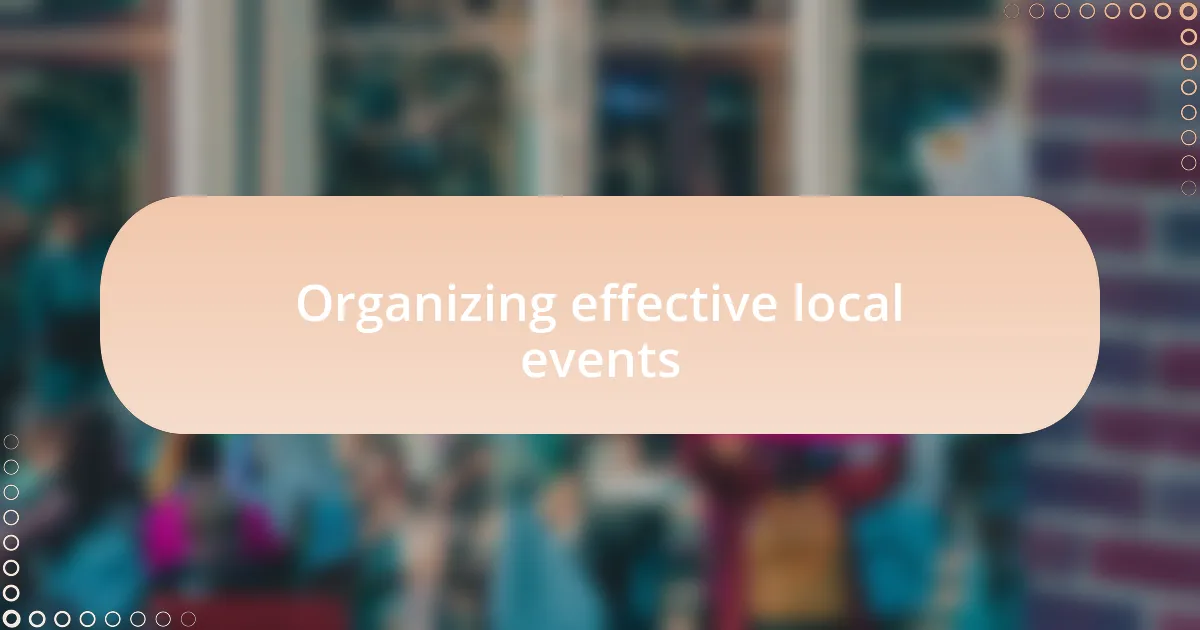
Organizing effective local events
Organizing local events requires a clear vision and community engagement. I learned this firsthand when I arranged a neighborhood peace rally in our local park. With just a few flyers and personal invites, we gathered a small crowd, but the energy was palpable. Seeing people share their stories and hopes ignited a strong sense of belonging and purpose among us. Have you ever felt the rush of connecting with others over a common cause? It’s truly a powerful motivator.
As we worked out the logistics, I realized how essential it was to involve everyone in the planning process. I encouraged my neighbors to share their ideas, which led to a series of creative workshops on art, music, and even storytelling. One neighbor suggested a mural project that reflected our values and aspirations. Watching the mural evolve over weeks, I felt a deep emotional connection to my neighbors, as our collective creativity turned the blank wall into a beacon of hope. Isn’t it fascinating how art can convey a message that words sometimes fail to express?
To ensure our events had lasting impact, I focused on follow-up. After our peace rally, we established regular meet-ups to discuss ongoing issues and plan future initiatives. I remember the excitement on the faces of attendees as they shared their newfound perspectives and commitments. This follow-through not only reinforced our solidarity but also transformed our gatherings into platforms for action. How have your interactions altered the way you view community mobilization? Each moment contributed to a growing, passionate movement that I’m proud to be part of.
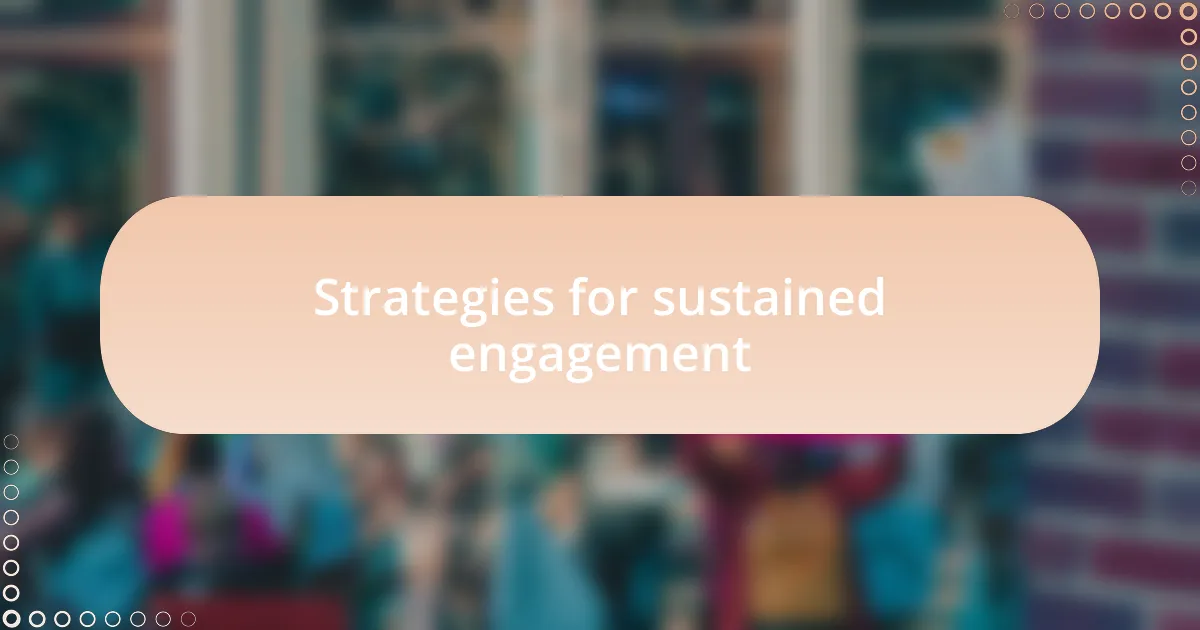
Strategies for sustained engagement
Finding ways to keep the momentum going is crucial in sustaining engagement. After our successful peace rally, I decided to implement a monthly book club centered on anti-war literature. It wasn’t just about reading; it became a space for deep discussions. Each meeting sparked intense dialogue about our world and personal experiences, forging stronger bonds among participants. Have you ever witnessed how a good book can open a window into someone else’s perspective? It’s extraordinary.
Another method that worked well for me was creating a shared online platform where we could communicate easily. I set up a simple group chat where we exchanged ideas, shared articles, and updated each other on local activism opportunities. It felt empowering to be part of a proactive community, addressing important issues together even when we were not physically together. I often found myself checking in just to see how everyone was doing. Doesn’t it feel nice to know that others are just a message away, ready to support you?
Lastly, incorporating fun and meaningful activities played a significant role in engagement. One memorable evening, I organized a potluck dinner for my neighbors where we shared our favorite dishes and stories about what activism meant to us. The laughter, delicious food, and heartfelt conversations filled our home with warmth and unity. How often do we allow ourselves to celebrate our collective victories, no matter how small? That night reminded me that activism isn’t just about protests; it’s also about cherishing the connections we forge along the way.
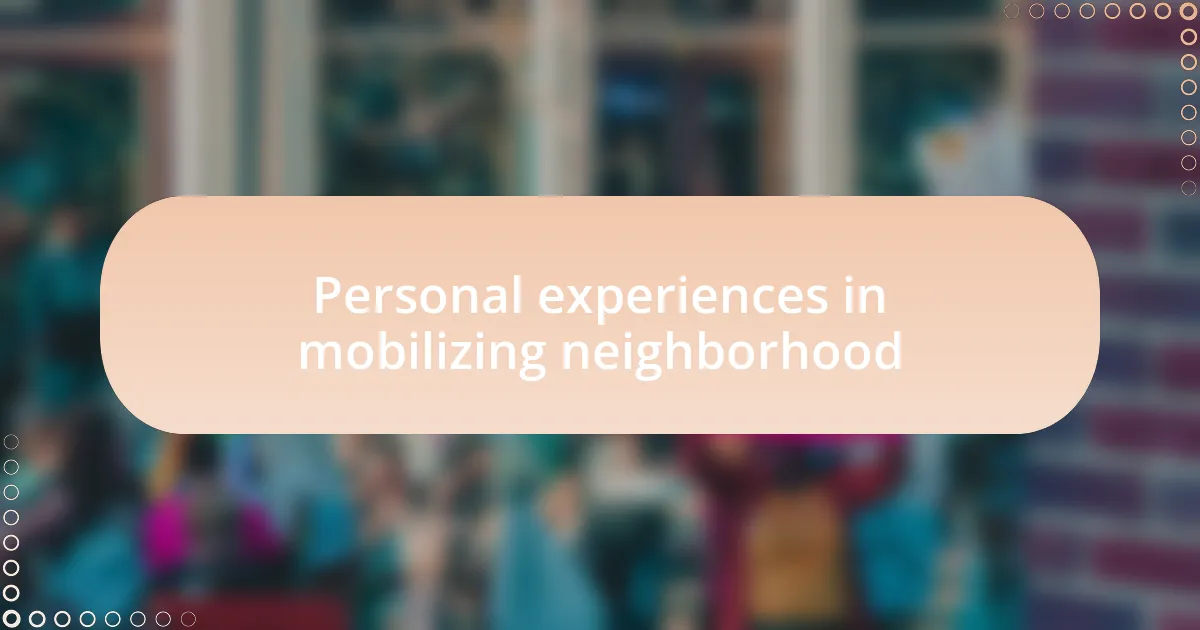
Personal experiences in mobilizing neighborhood
As I stepped outside to organize my first neighborhood meeting, I felt a mix of excitement and anxiety. Would my neighbors show up? To my surprise, the turnout was impressive, with people I barely knew sharing their concerns about war and peace. The moment became a turning point, as each voice added weight to our collective worry for the future. It was clear: this was no longer just my mission; it was ours.
One evening, I invited residents to write postcards to local representatives. The energy in the room was palpable; with pens in hand, we were tapping into our frustrations and hopes. I vividly recall a neighbor, typically reserved, passionately expressing their thoughts while jotting down poignant messages. That raw enthusiasm reminded me of the power we each hold when we stand together. Have you ever felt that surge of empowerment when everyone around you shares a common purpose?
Perhaps one of the most unforgettable moments was when we coordinated a neighborhood march for peace. It wasn’t just about the cause; it was about the people I walked alongside—friends, families, and even strangers who became allies. Seeing children carrying handmade signs next to their parents brought a sense of hope I hadn’t felt in a while. It made me wonder, what if we could inspire the next generation to prioritize peace? That experience solidified my belief that mobilizing a community can create ripples of change that extend far beyond our immediate surroundings.